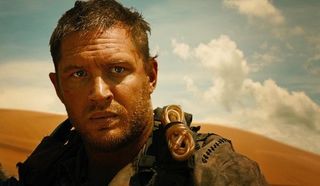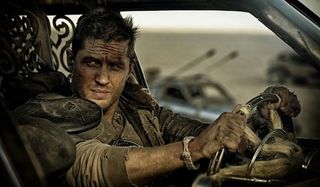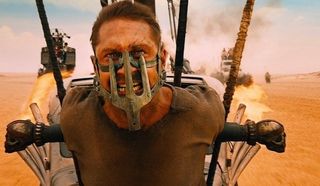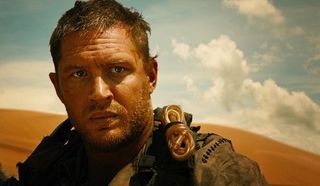Mad Max: Fury Road Ending -- That Mysterious Quote And What It Means

We’re going to talk about the end of Mad Max: Fury Road, which will obviously contain SPOILERS for the film in question. If you haven’t seen it yet, you should do so at the earliest convenience. It’s awesome. But maybe go read one of our other articles in the meantime.
For a movie called Mad Max: Fury Road, the character of Max Rockatansky, played by Tom Hardy taking over the role that made Mel Gibson famous, is hardly in the movie. He has a few grunts and gestures, even fewer actual lines (at one point Hardy estimated he had roughly 20), and to call him the main character is being generous. Then, at the end, he just disappears, melting into a crowd, on the road to his next post-apocalyptic adventure, and all we’re left with is a mysterious quote.
The last thing we see before the credits begin is a black screen with a quote that reads:
"Where must we go, we who wander this wasteland, in search of our better selves?"-The First History Man
That’s an esoteric way to end a movie, especially one where the title character (again, calling Max the "hero" is something of a misnomer) just wanders off, disappearing into a filthy, filthy throng after exchanging a quick head nod with Furiosa (Charlize Theron). The question is, what does this mean? For the character? For the future of the franchise? Does it explain why he left? Or where he is headed? Let's break it down!

It Means Mad Max Is The Reluctant Hero
Post-apocalyptic movies, including the Mad Max family of films, often take their cues from the western genre, stories where the grim, stoic man-of-action arrives on the troubled scene and takes measures, usually violent, to rectify the situation. Just as often, he’s a reluctant hero, one who doesn’t want to get involved initially, who only wants to look out for number one, but is moved by forces greater than himself to intervene.
Hardy’s Max is certainly a throwback to this archetype, only this time around they’ve taken the whole strong-but-silent thing to crazy-ass extremes, and swapped out horses for customized battlewagons and war rigs. This character type is also one with a past, and as you see, haunted by horrific visions, Max is certainly carrying around some rather hefty baggage with him as he wanders the sun-scorched wastes.
CINEMABLEND NEWSLETTER
Your Daily Blend of Entertainment News
Mad is both on a quest to find himself, his better self, and outrun his past. In 1979’s Mad Max, Max, played by Mel Gibson, loses his wife and infant son to a vicious motorcycle gang headed by Toecutter (Hugh Keays-Byrne, who also plays the villain Immortan Joe in Fury Road). In a ruined world already tearing itself apart, this was the last thing tethering Max to the remnants of civilization, and severing that final tie set him adrift, which we subsequently saw in The Road Warrior and Beyond Thunderdome.
On one hand, he floats through this desolate existence, just surviving. But on the other, as we see in Fury Road, as well as the earlier films, the flame of who he once was still burns inside of him—he was a cop, a husband, a father, a good man—which is the part of him that won’t let him walk away from trouble.
He wants to get away, to be left alone with his pain and his memories, but at the same time he can’t stand aside and not help when he’s needed. The lasting impression and legacy of his family (though in Fury Road he flashes back to a little girl, not his son, which potentially indicates further loss and trauma, and there are some interesting fan theories floating around about that particular tidbit), his wife’s belief that he is still a good man, is what drives him forward.
He may not go looking to play the hero, or just to help as is the case in Fury Road, but in a world full of trouble and strife, he has the opportunity to step into that role. With Immortan Joe toppled, with a good and just and strong leader like Furiosa installed at the Citadel, and the wives safe, his job, for lack of a better word, is done, and he’s free to ride off... and likely be a reluctant hero once again.

It Means Mad Max Is A Heroic Myth
Discussing the continuity of the Mad Max franchise, George Miller has often stated that Max, in whatever form he takes, is a mythic figure, more legend than man. Again, hearkening back to westerns, tales get passed along from person to person, with fuzzy details remembered and replaced, until it’s damn near impossible to differentiate between what is real and what is fabricated.
Miller’s point is that, perhaps, not all of these adventures actually happened in this universe as we see them in the movies. Bits and pieces may be true, but the implication is that Max is larger than just a man, he’s a fable, a folk tale. For example, the popular notion of Billy the Kid is much, much different than the reality, and it’s difficult to separate the actual person from the tales of the frontier outlaw.
This idea is given some credence by the very nature of how this information is disseminated. In this wrecked future, there aren’t history books or news broadcasts or Wikipedia, nothing is written down, or at least nothing is written down and mass-produced for public consumption. What we have here is a society based on the oral tradition, one that is essentially made up of stories and tales passed from one person to another. The same goes for maintaining a history. The quote at the end of Fury Road comes from the First History Man, one in a line of similar record keepers.
Before the film came out, Miller said Fury Road is the story of the Road Wars and "is based on the Word Burgers of the History Men and eyewitness accounts of those who survived." We’ve seen history kept alive in this manner before in the saga, specifically at the end of Beyond Thunderdome. After the survivors Max helps escape from Bartertown find the ruins of Sydney and establish a small society, Savannah, the leader, recites the story of their journey and the stranger who saved them, while at the same time, Max is still out there, wandering the desert.
This adds fuel to the idea that the stories of Mad Max that we see on screen are not intended to be the hard and fast truth, but pieces of a larger mythological tapestry. Similar theories have been kicked around in regards to people trying to figure out where Fury Road fits into the greater continuity of the Mad Max saga. However, viewed as a not-entirely-real figure, maybe it doesn’t have to have a concrete place in the timeline.
It’s a post-apocalyptic version of tales being swapped between cowboys traveling between frontier outposts. The person in the story may very well have started out as just a man, but evolved into something else over time. As more of a heroic myth than a man, at the end of Fury Road, Max tips his metaphorical hat and wanders out into the wilderness, on to his next adventure.

It Means Mad Max Wanders Into The Wasteland
While Mad Max: Fury Road was critically adored, perhaps way more than anyone expected—it currently has a 97% "fresh" rating on review aggregator Rotten Tomatoes—it wasn’t a huge financial success, especially at first. It took years to make, including having one of its initial filming locations wiped off of the map by unseasonal flooding, and required expensive reshoots—principal photography wrapped late in 2012, but the film didn’t hit theaters until May of this year. All of these production delays, coupled with a spiraling budget that eventually topped $150 million and a pricey marketing campaign, added up to one hell of a costly movie.
After barely topping its production budget domestically (it made $153 million in the U.S.), Fury Road has raked in $374 million globally. Though that’s a tidy sum, it wasn’t quite the overwhelming blockbuster the studio hoped for, and the possibility of more films isn’t a given—initially, Miller intended to film two films back-to-back, but with the delays, that didn’t happen.
While another Mad Max hasn’t been officially give the green light, that didn’t stop the 70-year-old director from talking about the future. He has said that there are more ideas floating around, including scripts and the novelization of a Max story, but the most interesting thing he said is that the next film, assuming it happens, will be called Mad Max: Wasteland.
This may be a stretch, but does part of that final quote, the "we who wander this wasteland," point towards the future of the franchise? Fury Road is an idea George Miller has been kicking around for years—it took 30 years after Beyond Thunderdome in 1985—and he obviously has more plans, or at least potential plans in mind. It’s possible this is a bit of a plant.
Told you it was a stretch. But just the fact that this quote comes from the "First" History Man, implies that there is much more to this world than what we see, that Fury Road is in fact just a single piece of a larger record. World War I wasn’t called World War I until the second one came about, so if they’re referring to the First History Man, the implication is that there have been more to follow. This indicates that there is a wealth of other stories that exist out there in this particular universe, and we’re definitely okay with going back for more. Let’s just hope it doesn’t take another three decades.
Already named the best movie of movie of the year by one group of critics, Mad Max: Fury Road recently roared on to Blu-ray, which will give us the opportunity to watch and dissect the ending time after time. No matter what your interpretation of why Max leaves, what his role is, or what lies ahead for him in the future, this is a conclusion that certainly leaves the door open for more films, and one that will continue to spark discussion and debate.
Most Popular







